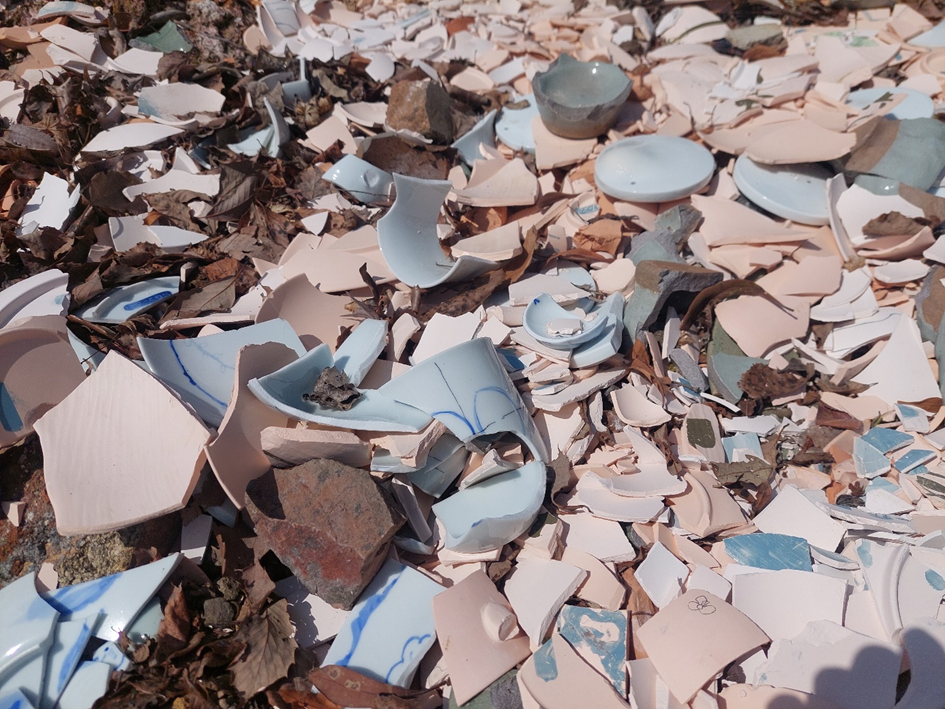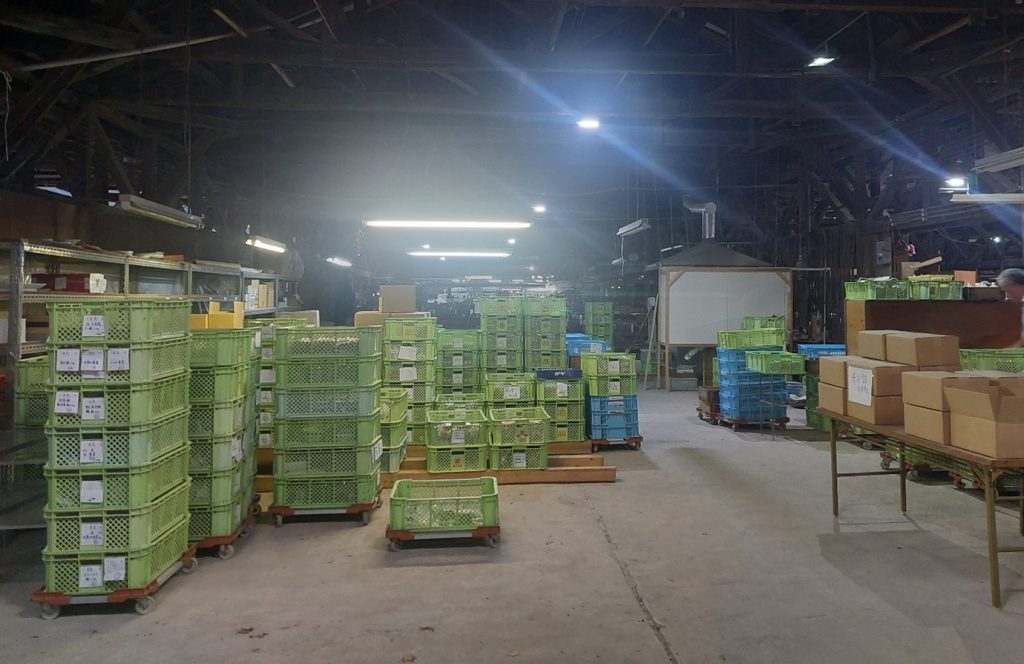by Cornelia Reiher
Two of our field sites are known for porcelain. The porcelain industry in Arita has experienced a steady downward trend since the 1990s. Not only turnover, but also the number of workshops, retail stores and employees has fallen sharply (Arita-cho 2023: 9; Reiher 2010, 2014). Some kilns have closed and are empty or have been demolished. What remains are empty properties and lots of porcelain shards that can be found all over the city: in rivers, next to abandoned ascending kilns (noborigama) or where porcelain factories used to be. But it’s not just shards that are left over; large quantities of unsold products with flaws are also kept in warehouses, which are often on the verge of collapse themselves.

Copyright © Cornelia Reiher 2023
Recently, both locals and newcomers have started to reuse and upcycle porcelain shards and discarded porcelain. For example, a migrant potter who works in a kiln in Arita makes new products from older B-ware that have been stored in the forest for many years and are now cracked. The potter, who is very interested in sustainability, has tracked down these pieces and painted over the cracks with golden lines, in the style of kintsugi. She told me how shocked she was when she found out about the huge amounts of B-ware in the forests, and that she wondered why the kiln she works for was not doing anything with it. She thought it would be better to rediscover what was already there rather than keep making new things, and applied for funding to test and excavate the pieces to see if they were broken. After cleaning and firing 500 pieces, they are now sold as small flower vases. By upcycling porcelain, the potter created a popular new product that is also sold via the furusato nōzei system. This home-town tax payment is a system that allows people to transfer a portion of their residence tax from the municipality where they reside to one or more other municipalities in exchange for gifts like the upcycled flower vase.

Copyright © Cornelia Reiher 2023
But not all the porcelain products stored in Arita’s kilns are cracked or broken. Some kilns have gone bankrupt and unsold porcelain is taking up space. Others want to get rid of the old porcelain in order to reuse their storage space. With so much porcelain sitting around in many kilns, one company came up with the idea of selling old porcelain in a tsume hōdai style. The porcelain is lined up in boxes in an unused part of the kiln and customers fill baskets for 5,000 yen or 10,000 JPY. They can take as much porcelain as they can find and fit into the basket within an hour. This idea became a huge success, bringing a lot of money and attention to the kiln.

Copyright © Cornelia Reiher 2023
This so-called treasure hunt is even listed as a tourist attraction in the Lonely Planet travel guide and attracts Japanese and foreign tourists to the kiln. The kiln now also receives porcelain for the treasure hunt from other kilns that have been closed. When I visited the kiln after the travel ban to Japan was lifted, the place was busy with tourists from China and India. The person in charge also told me that people come very early to make sure there is still good porcelain available. Rummaging through the dusty boxes of porcelain was indeed a lot of fun. But beyond that, it is also a great opportunity to reuse old porcelain that can no longer be sold.

Copyright © Cornelia Reiher 2022
Initiatives such as the two described above are still rare and will not solve all the problems caused by the decline of the ceramics industry in Arita. There are still many unused kilns and unsold porcelain in the city. However, they are the first steps in rethinking the future of a traditional industry from a sustainability perspective, both in terms of environmental issues and the preservation of Arita’s cultural heritage. And they can be an inspiration for further projects, as new ideas are also emerging elsewhere in Arita. Recently, for example, jewelry made from porcelain shards has become very popular and is sold in a store in Arita, at the annual ceramics fair and online. It seems that the kilns in Arita are ready to incorporate sustainability, reuse and upcycling more into their future business strategies.
References:
Arita-chō (2023), Statistical Yearbook 2022, https://www.town.arita.lg.jp/site_files/file/2023/202306//6486cd3bc6adfLD3AXP72.pdf
Reiher, Cornelia (2014), Lokale Identität und ländliche Revitalisierung. Die japanische Keramikstadt Arita und die Grenzen der Globalisierung, Bielefeld: transcript.
Reiher, Cornelia (2010) „Selling tradition in Japanese rural tourism“, Orientwissenschaftliche Hefte 28, pp. 121–151.
